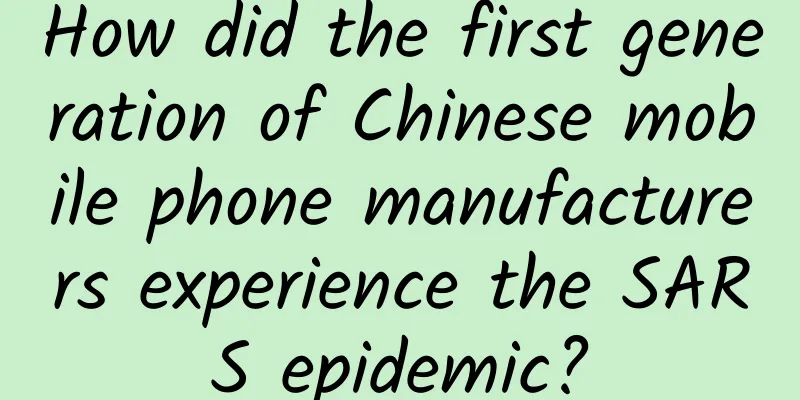How did the first generation of Chinese mobile phone manufacturers experience the SARS epidemic?

|
Everyone has seen the impact of the novel coronavirus pneumonia epidemic on work and life. In order to control the spread of the epidemic and avoid crowds, people have reduced their travel frequency, the frequency and opening hours of public transportation and public places have also been significantly reduced, and most companies have postponed their start of work. As part of China's business environment, the mobile phone market is also affected. Whether it is the offline stores of Apple, Xiaomi and other manufacturers announcing the suspension of business, or the loss of production capacity of factories in the supply chain, or the new product launch conferences originally planned to be held have all been turned into online live broadcasts, the Chinese mobile phone industry has undergone real changes.
It is not just the Chinese mobile phone market that is affected. Research firm Strategy Analytics recently predicted that China's mobile phone shipments will decline by more than 30% in the first quarter, and annual shipments will be 5% lower than expected. The global mobile phone market, which is closely related to China's industrial chain, will also decline by 2%. During this epidemic, many companies that have experienced SARS have taken relatively positive actions to get through it smoothly. During the SARS epidemic in 2003, the mobile phone industry was no exception and was affected just like all industries. Therefore, it is necessary for us to review the past and see which views and actions are still valuable today. Mobile phone sales declined during the SARS period, but communication time increased The SARS outbreak in China was mainly concentrated in the first half of 2003, more precisely from February to June, i.e. the first two quarters. This period was always a time for the mobile phone and the entire communications industry to release new products and set annual goals and strategies, but it was ruthlessly disrupted by the epidemic. At that time, mobile phone sales were still very dependent on offline channels. After the outbreak of the epidemic, measures such as reduced traffic and store closures were bound to lead to a significant decline in sales performance. After conducting a survey of mobile phone dealers in Beijing and Shanghai, JPMorgan Chase analyst Xia Bowen said that sales during the epidemic fell by about 40% compared to usual. It was not until late May when the SARS epidemic was greatly alleviated, people were able to travel more freely, and computer malls and mobile phone stores were reopened, that the mobile phone market began to recover its former vitality. The decline in mobile phone industry sales during the SARS period also caused the commission and one-to-one sales model commonly used by domestic manufacturers to "fail" due to cost constraints, and international brands saw a short-term recovery in market share. Fortunately, the decline in sales performance in the first half of the year did not have much impact on the whole year. According to data released by Analysys International, a total of 73.78 million mobile phones were sold in the Chinese market in 2003, an 8.24% improvement over the 68.16 million in the previous year. The Chinese mobile phone market survived the SARS epidemic. Due to the objective condition that all kinds of mobile communication services still need to go to physical business halls to handle, the user growth rate of the three major operators has slowed down due to the reduction of going out. According to the Beijing Entertainment News, China's mobile phone users increased by 5.7 million per month in the first four months of 2002, but during the SARS period, the number dropped to 5.02 million per month, and in April 2003, there were only 4.23 million users. However, under the premise of a significant reduction in people's travel, communication needs across the country have been stimulated, and the frequency of users' calls and text messages has increased significantly. In April of that year, China Unicom saw a 40% increase in user call duration compared to the previous month. According to statistics from the Ministry of Industry and Information Technology, the total number of new mobile communication users in the whole year was 62.68 million, in line with expectations of the previous year. Since most factories were not located in the high-incidence areas of the disease that year, the impact on China's mobile phone manufacturing was not obvious. In the first half of 2003, 74.13 million mobile phones were produced, which met industry expectations. The industry also remained optimistic. PCB board supplier Zhanhua once said that the original global target of 80 million was difficult to achieve, but the domestic market still had a demand of nearly 60 million, which was the same as the previous year and continued to expand production capacity. International manufacturers were slightly affected, but basically survived smoothly In 2003, 3G networks had just begun to be put into use around the world, but China was still far from 3G, and 2G mobile phones still dominated the market. In addition to 3G and its peripheral functions, mainstream mobile phone selling points have entered the market: the concept of mobile GPRS Internet access has begun to emerge, color screen mobile phones have begun to be popular, and color ringtones and multimedia messages have also become fashionable for a period of time. Even though there were some bright spots that impressed consumers at that time, both international and domestic manufacturers could not escape the collateral effects of the SARS epidemic. Motorola once said that due to the decline in Chinese residents' consumption expenditure due to the epidemic, sales in the second quarter of that year would not be able to meet the expected target. As soon as the news was released on June 9, not only did Motorola's own stock price fall by 3.6%, but also the stocks of European and American communications companies such as Texas Instruments fell. After a project manager was diagnosed with SARS, Motorola entered a work-from-home mode from April 29 until it was lifted. Motorola's Tianjin factory also entered a shift mode, and production speed was significantly slowed down. The press conferences and other activities that were originally scheduled to be held were also cancelled one by one.
In this year, Nokia launched a more fierce attack on Motorola, the market leader at the time, and launched the gaming phone N-Gage and mobile phones with music and camera functions in the international market. It also began to introduce emerging CDMA models in China. However, under the premise of an unoptimistic overall environment, Nokia also lowered its market expectations. Samsung, which was preparing to expand its presence in the mobile phone market, was also affected by the SARS epidemic and failed to achieve its second quarter sales target. In 2002, the Chinese market provided Samsung with $32 billion in sales, accounting for 20% of its annual revenue. However, looking at the whole year, the three international mobile phone manufacturers all survived the SARS epidemic. Motorola reversed its loss of $2.5 billion in the past year and earned a net profit of $893 million; Nokia also returned to sales and profit growth, with a global share of 38%; Samsung mobile phones also further established their foothold in China. In general, the epidemic cycle of more than a quarter did not affect the market strategy of international mobile phone manufacturers in China too much. Apart from changing the working method and slowing down the production speed in response to the epidemic, they basically carried out according to the original plan. Due to the competitiveness of the products themselves and the appeal of international brands, the market performance throughout the year was in line with expectations. Although the business suffered losses due to the epidemic, mobile phone manufacturers have all extended a helping hand and fulfilled the social responsibility that commercial companies should have. Nokia, Motorola, Alcatel, Shouxin, Siemens, Panasonic, Sony Ericsson, UTStarcom, Bird and other companies have donated mobile phone products, cash and medical supplies to medical staff and relevant departments. Domestic manufacturers seize the opportunities hidden in the epidemic Different from the market strategy of international manufacturers that focused on brand image and mid-to-high-end selling points, domestic mobile phone manufacturers launched a price war at the time to seize the market from the former. Some analysts predicted during the SARS epidemic that the decline in sales due to the decline in traffic would put a pause on the increasingly fierce price war. However, in fact, the special environment during the SARS period made domestic manufacturers more aggressive in their market strategies. Compared with the international manufacturers who occupied the mid-to-high-end market at that time and were still unwilling to let go, the price war of domestic mobile phones seems very familiar now: color screens, MMS, Cailai, GPRS, etc. were still new, and selling points that cost thousands of yuan for international brands became standard features in the thousand-yuan level for domestic mobile phones. In today's words, they were very cost-effective.
On the other hand, domestic mobile phones also took advantage of price and other advantages to establish a huge channel to penetrate the sinking market early. During the SARS period, the situation in first-tier cities such as Beijing, Guangzhou, and Shanghai was relatively serious, and stores also responded to the request to suspend business. However, the operation of third- and fourth-tier cities was not greatly affected, and many sales outlets were still open. In such a contrast, some mobile phone brands even achieved a continuous increase in sales, and the market share of domestic mobile phones began to surpass that of international mobile phone brands. The low-price, multi-function and multi-channel strategy is undoubtedly feasible. By the end of 2003, domestic mobile phones had captured more than 54% of the market. Bird spent 258 million yuan on marketing that year, and became the manufacturer with the largest market share that year with nearly 10 million units sold. The relatively simple threshold and sales model of the mobile phone industry made price wars successful. After drastically reducing prices during the SARS period and stimulating sales through incentives such as cars, Bird sold 2 million more units than the second-ranked Motorola in 2003.
TCL, the second-largest domestic mobile phone brand at the time, also had a terrifying sales volume of about 7.5 million, and later reached a cooperation with the French mobile phone brand Alcatel. Panda, Amoi, Kejian and other mobile phone manufacturers also delivered answers that met expectations. Domestic mobile phones seemed to be unaffected by SARS and were in the limelight for a while. After that, it was a series of downhill roads: both Bird and other manufacturers saw their sales drop sharply in the next few years, and eventually disappeared from the market. The international manufacturers that were once regarded as the biggest rivals survived to the next era. Domestic mobile phones survived SARS, but they did not overcome their own problems. In general, the epidemic did not have a serious impact on the mobile phone industry. Instead, internal problems triggered the first reshuffle of the Chinese mobile phone industry. They chose to trade profit margins for sales, but their limited innovation capabilities made it impossible to convert sales into long-term market share. Quality issues also led to tens of millions of inventory, which knocked down Domino's first card. Although their performance during the SARS period seemed brilliant, it could not hide the fact that the first batch of domestic mobile phone manufacturers were weak inside, which directly led to the outcome of almost all of them being eliminated a few years later. Online channels are gaining momentum Although we ended up in a mess back then, we can still find some directions that may serve as a guiding light for current mobile phone manufacturers to safely survive the COVID-19 epidemic. The power of sales channels cannot be ignored. The decline in the number of actual purchasing users is not terrible. What is terrible is the inability to reach users with products. Domestic manufacturers once seized the opportunity that international manufacturers could not effectively enter the sinking market, and played a combo in the adverse environment of the epidemic, becoming the choice of more consumers. What we need to focus on now is undoubtedly the online channel, which will become the main channel for mobile phone sales in the first half of 2020. Not only are mobile phone product launches now purely online, but the convenience of shopping and payment, as well as the advantage of contactless delivery, also make online channels the mainstream in this era.
The COVID-19 has a stronger ability to spread, requiring stricter isolation measures. In addition, due to the two-week incubation period, the impact on mobile phone sales may be longer. Going out for shopping and opening a business are inconvenient, which may have a greater impact on offline sales channels and outlets, and may also prompt manufacturers that originally relied heavily on offline sales to make significant efforts online. Because the impact of the epidemic lasts longer, mobile phone manufacturers have to devote more energy to thinking about how to survive. The time required for design, production, sales, and delivery has become longer, but various costs and bills are still running at the original cycle, which is likely to cause considerable financial pressure. Moreover, 5G-related research and development in the past two years has consumed a large amount of budgets of various manufacturers, which is particularly pessimistic for relatively small manufacturers. Fortunately, after several rounds of reshuffles, the mobile phone manufacturers that have survived in the Chinese market have relatively strong strength, and the possibility of capital shortage due to the decline in sales caused by the epidemic is relatively small. 5G is both a pressure and an opportunity. After a whole year of warming up and waiting last year, the market is at a critical juncture for the comprehensive upgrade of 5G. There are a large number of subjective and objective demands among consumers, which are expected to be transformed into market performance; after SARS, there was retaliatory consumption in the field, which may happen again after the end of this epidemic. However, we should not be too optimistic. The impressive market performance after SARS is inseparable from the demographic dividend and the fact that the entire national economy is in an upward period. Now the Chinese mobile phone market has transformed into a stock market, which is no longer the same as the environment back then. Learning from experience and lessons and finding a suitable positioning and route for themselves is the appropriate way for mobile phone manufacturers to smoothly overcome difficulties. |
<<: The developer website was accidentally launched, and Android 11 may provide these features
Recommend
The greener the leaves, the fresher the rice dumplings? Can wormwood prevent plague? Check out the rumors about the Dragon Boat Festival
Is drinking realgar wine like drinking arsenic? C...
Price hikes saved Gong Yu but not iQiyi
This week, iQiyi announced a new round of members...
Do you think the official version of iOS 10.2 improves iPhone battery life?
iOS 10.2 is Apple’s latest iOS operating system. ...
How to rename an unnamed WeChat applet?
Q: How to rename an unnamed WeChat applet? A: How...
Why Are Your Facebook Ads Burning Money So Fast?
When you run Facebook ads , one of the most impor...
ChatGPT is equivalent to a 9-year-old human child. Does it really think of itself as a human being?
If you ask what the hottest technology terms on t...
Are mobile programmers going to be out of business under the big front-end trend? These advanced skills will help you turn things around
In the context of market contraction and the tren...
From the perspective of user motivation and long-term value, analyze how to retain users?
This article analyzes how to retain users from th...
APP promotion: mainstream customer acquisition channels and methods
With the development of App development technolog...
Jellyfish are cute and delicious? But being stung by them is terrible and can be fatal!
Jellyfish salad is refreshing and appetizing, and...
How to modify SEO when a new website is launched? How to perform SEO optimization?
Due to inadequate early planning of location cons...
Why do allergies always occur in spring?
Spring is supposed to be a beautiful season full ...
How to write excellent promotional copy?
For many operations and promotion personnel, crea...
The 6-step core self-examination checklist for community operations, a must-read!
Through years of operational practice, I have sum...
QQ is updated again! A wave of new features is coming
Recently, Tencent QQ iOS version has been updated...









